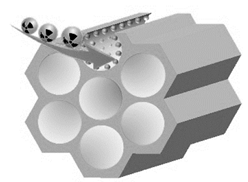Advantages:
- High absorption capacity
- Fast and controllable kinetics
- Facile regeneration and recyclability
- Stable under a wide range of conditions
- High density of chelating sites
Summary:
Water and energy purification are important factors in minimizing the harsh impact of technology on the environment. Coal-powered fuel stations and waste incinerators are constantly releasing toxic heavy metals into the environment. Mercury is an extremely hazardous heavy metal, yet an estimated 6,000 tons are emitted into the atmosphere each year. Due to mercury’s elemental properties, it is able to gain admittance into a constant cycle of entry and reentry into the atmosphere, soil, water, and ultimately food as methylmercury. Methylmercury is a potent neurotoxin and can cause serious harm to humans as well as severe birth defects in expectant mothers. Furthermore, nuclear energy remains at the forefront of untapped energy potentials. However, the potential role of these radioactive materials, such as uranium, is limited by their extreme toxicity. The removal and recovery of radioactive materials is difficult and requires specific sorbent materials. Hence, it is imperative that researchers find a way to effectively remove these toxic chemicals from the environment.
Ourresearchers have used a free radical polymerization method to produce a functionalized porous organic polymer. This composition has a stable and recyclable mercury and uranium uptake, is cost-effective, and contains a high density of chelating sites for mercury capture. This porous organic polymer may expand the scope of current applications by successfully binding contaminants from a water source.

The Microscopic Pore Sizes of the Polymer Allows for an Extremely Efficient Contaminant Capture.
Desired Partnership:
License